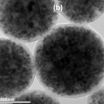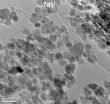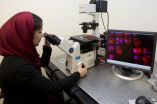(Press-News.org) In current research related to improving cancer treatments, one promising area of research is the effort to find ways to selectively pinpoint and target cancer cells while minimizing effects on healthy cells.
In that effort, it's already been found in lab experiments that iron-oxide nanoparticles, when heated and then applied specifically to cancer cells, can kill those cells because cancer cells are particularly susceptible to changes in temperature. Increasing the temperature of cancer cells to over 43 degrees Celsius (about 109 degrees Fahrenheit) for a sufficient period of time can kill those cells.
So, a University of Cincinnati-led team – along with researchers at Iowa State University, the University of Michigan and Shanghai Jiao Tong University – recently conducted experiments to see which iron-oxide nanoparticle configurations or arrangements might work best as a tool to deliver this killing heat directly to cancer cells, specifically to breast cancer cells. The results will be presented at the March 3-7 American Physical Society Conference in Denver by UC physics doctoral student Md Ehsan Sadat.
In systematically studying four distinct magnetized nanoparticle systems with different structural and magnetic properties, the research team found that an unconfined nanoparticle system, which used an electromagnetic field to generate heat, was best able to transfer heat absorbed by cancer cells.
So, from the set of nano systems studied, the researchers found that uncoated iron-oxide nanoparticles and iron-oxide nanoparticles coated with polyacrylic acid (PAA) – both of which were unconfined or not embedded in a matrix – heated quickly and to temperatures more than sufficient to kill cancer cells.
Uncoated iron-oxide nanoparticles increased from a room temperature of 22 degrees Celsius to 66 degrees Celsius (about 150 degrees Fahrenheit).
Iron-oxide nanoparticles coated with polyacrylic acid (PAA) heated from a room temperature of 22 degrees Celsius to 73 degrees Celsius (about 163 degrees Fahrenheit.)
The goal was to determine the heating behaviors of different iron-oxide nanoparticles that varied in terms of the materials used in the nanoparticle apparatus as well as particle size, particle geometry, inter-particle spacing, physical confinement and surrounding environment since these are the key factors that strongly influence what's called the Specific Absorption Rate (SAR), or the measured rate at which the human body can absorb energy (in this case heat) when exposed to an electromagnetic field.
According to Sadat, "What we found was that the size of the particles and their anisotropic (directional) properties strongly affected the magnetic heating achieved. In other words, the smaller the particles and the greater their directional uniformity along an axis, the greater the heating that was achieved."
He added the systems' heating behaviors were also influenced by the concentrations of nanoparticles present. The higher the concentration of nanoparticles (the greater the number of nanoparticles and the more densely collected), the lower the SAR or the rate at which the tissue was able to absorb the heat generated.
THE FOUR SYSTEMS STUDIED
The researchers studied
uncoated iron-oxide nanoparticles
iron-oxide nanoparticles coated with polyacrylic acid (PAA)
a polystyrene nanosphere with iron-oxide nanoparticles uniformly embedded in its matrix
a polystyrene nanosphere with iron-oxide nanoparticles uniformly embedded in its matrix but with a thin film surface of silica
All four nanoparticle systems were exposed to the same magnetic field for 35 minutes, and temperature measurements were performed at two-minute intervals.
As stated, the PAA iron-oxide and the uncoated iron-oxide samples showed the highest temperature change. The lowest temperature changes, insufficient to kill cancer cells, were exhibited by
The polystyrene nanosphere, which heated to 36 degrees Celsius (about 96 degree Fahrenheit).
The polystyrene nanosphere with a silica coating heated to 40 degrees Celsius (104 degrees Fahrenheit).
INFORMATION:
In addition to Sadat, others on the research team include Ronak Patel, former master's student in materials sciences and engineering in UC's College of Engineering and Applied Science; Jason Sookoor, undergraduate neuroscience student from UC's McMicken College of Arts and Sciences; Sergey L. Bud'ko, adjunct associate professor, Ames Laboratory and Department of Physics and Astronomy, Iowa State University; Rodney C. Ewing, Edward H. Kraus distinguished university professor, University of Michigan; Jiaming Zhang, assistant research scientist, University of Michigan; Hong Xu of the Med-X Institute, Shanghai Jiao Tong University; Giovanni M. Pauletti, associate professor in UC's James L. Winkle College of Pharmacy; David B. Mast, associate professor of physics in UC's McMicken College of Arts and Sciences; and Donglu Shi, professor of materials science and engineering at UC's College of Engineering and Applied Science.
Support for this research was provided by a National Science Foundation grant under contract number NSF (1343568) titled "Development of Nanotechnology Minor Focused on Nano Biomedicine and Sustainable Energy." Work at the Ames Laboratory was supported by the United States Department of Energy, Basic Energy Sciences, Division of Materials Sciences and Engineering.
UC research tests which nano system works best in killing cancer cells
2014-03-04
ELSE PRESS RELEASES FROM THIS DATE:
The chemistry (and fascinating history) of pepper, the spice that changed the world
2014-03-04
WASHINGTON, March 3, 2014 — Pepper is one of the most plentiful condiments in the world today, but it used to be more valuable than gold. In the American Chemical Society's (ACS') latest Reactions video, we examine how pepper's delectable chemistry made it a key player in the global spice trade. The sought-after spice helped usher in the "Age of Discovery," which bridged the gap between the Middle Ages and the Modern era. And because we're celebrating our second month of existence, it's a Reactions double feature this week. In our second video, we examine the science behind ...
Team models photosynthesis and finds room for improvement
2014-03-04
CHAMPAIGN, Ill. — Teaching crop plants to concentrate carbon dioxide in their leaves could increase photosynthetic efficiency by 60 percent and yields by as much as 40 percent, researchers report in a new study.
The team used a computer model to simulate how adding genes from a type of photosynthetic algae known as cyanobacteria might influence photosynthetic efficiency in plants. Cyanobacteria contain small structures, called carboxysomes, which concentrate carbon dioxide at the site of photosynthesis.
"Photosynthesis is the most studied of all plant processes, so ...
Scientists identify protein linked to most common movement disorder
2014-03-04
Quebec City, March 3rd, 2014—A team of researchers from Université Laval and CHU de Québec identified unusually high levels of a certain protein in the brains of people suffering from essential tremor (ET), a movement disorder that affects 4% of the adult population. The discovery, the details of which were published in the most recent edition of the journal Movement Disorders, could lead to an effective treatment for this neurological condition, which is 10 times more prevalent than Parkinson's disease.
As its name suggests, ET causes tremors in various parts of the ...
UC research tests range of electrical frequencies that help heal chronic wounds
2014-03-04
Naturally occurring electricity in our cells is key to how our bodies function, and that includes the healing of wounds.
And externally applied low-amplitude electric fields have been shown to help hard-to-heal chronic wounds, like those associated with diabetes, where there is insufficient blood supply and drug treatments are not effective. The externally applied electric field manipulates the body's naturally occurring electricity, such that the new vessels are formed, and blood supply to the wound is increased.
University of Cincinnati physics and biomedical engineering ...
Cigarette smoking may cause physical changes in brains of young smokers, UCLA study shows
2014-03-04
The young, it turns out, smoke more than any other age group in America. Unfortunately, the period of life ranging from late adolescence to early adulthood is also a time when the brain is still developing.
Now, a small study from UCLA suggests a disturbing effect: Young adult smokers may experience changes in the structures of their brains due to cigarette smoking, dependence and craving. Even worse, these changes can occur in those who have been smoking for relatively short time. Finally, the study suggests that neurobiological changes that may result from smoking ...
Pitt public health analysis provides guidance on hospital community benefit programs
2014-03-04
PITTSBURGH, March 3, 2014 – A new analysis led by the University of Pittsburgh Graduate School of Public Health offers insights for nonprofit hospitals in implementing community health improvement programs.
In a special issue of the Journal of Health Care for the Poor and Underserved that focuses on the Affordable Care Act (ACA), a multidisciplinary team of Pitt researchers explore published research on existing community benefit programs at U.S. hospitals and explain how rigorous implementation of such programs could help hospitals both meet federal requirements and ...
New study reveals insights on plate tectonics, the forces behind earthquakes, volcanoes
2014-03-04
The Earth's outer layer is made up of a series of moving, interacting plates whose motion at the surface generates earthquakes, creates volcanoes and builds mountains. Geoscientists have long sought to understand the plates' fundamental properties and the mechanisms that cause them to move and drift, and the questions have become the subjects of lively debate.
A study published online Feb. 27 by the journal Science is a significant step toward answering those questions.
Researchers led by Caroline Beghein, assistant professor of earth, planetary and space sciences ...
Novel drug treatment protects primates from deadly Marburg virus
2014-03-04
For the first time, scientists have demonstrated the effectiveness of a small-molecule drug in protecting nonhuman primates from the lethal Marburg virus. Their work, published online in the journal Nature, is the result of a continuing collaboration between Army scientists and industry partners that also shows promise for treating a broad range of other viral diseases.
According to senior author Sina Bavari, the drug, known as BCX4430, protected cynomolgous macaques from Marburg virus infection when administered by injection as long as 48 hours post-infection. Bavari ...
Manufacturing a solution to planet-clogging plastics
2014-03-04
Researchers at Harvard's Wyss Institute have developed a method to carry out large-scale manufacturing of everyday objects – from cell phones to food containers and toys – using a fully degradable bioplastic isolated from shrimp shells. The objects exhibit many of the same properties as those created with synthetic plastics, but without the environmental threat. It also trumps most bioplastics on the market today in posing absolutely no threat to trees or competition with the food supply. The advance was reported online last week in Macromolecular Materials & Engineering. ...
Pediatric surgeons develop standards for children's surgical care in the United States
2014-03-04
Chicago (March 3, 2014): The American College of Surgeons (ACS) has published new comprehensive guidelines that define the resources the nation's surgical facilities need to perform operations effectively and safely in infants and children. The standards—published in the March issue of the Journal of the American College of Surgeons—also have the approval of the American Pediatric Surgical Association and the Society of Pediatric Anesthesia. Representatives of these organizations as well as invited leaders in other pediatric medical specialties, known as the Task Force ...





